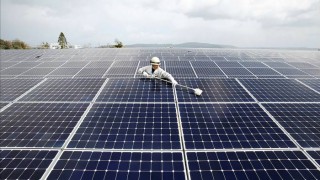Loading
Search
▼ Sun Fails To Shine On Japan’s Solar Sector
- Category:Other
A flagship energy scheme has been undermined by policy shifts and adverse demographics
It was a speech to inspire environmentalists and energy investors. Addressing both houses of Japan’s parliament last October, new prime minister Yoshihide Suga vowed to make a “green society” a core focus of his government.
Among the most promising technologies for bringing this about, he said, would be solar power. The problem — even as he made the announcement and sent bureaucrats scrambling to create the programmes to make it happen — was Japan’s growing list of solar company failures.
And while shifts in government policy have played a part in these, some analysts see a more worrying dynamic: the possibility that the economics of solar power in Japan reveal a serious threat to its sustainability plans.
Between the start of 2018 and the end of 2020, 256 solar companies were forced to declare bankruptcy, according to business information firm Teikoku Databank. Their failure, surviving competitors say, reflects a far more challenging operating environment than many had ever predicted.
The rate of new bankruptcies currently appears to be falling, but analysts at Tokyo Shoko Research note that last year the total debt of bankrupt solar companies almost doubled from 2019 levels — reaching a record ¥46bn ($415m).
They suggest that emergency Covid-19-related subsidies may be masking the full extent of the crisis. “Businesses supported by financial assistance may be ‘short of breath’, and the number of bankruptcies in 2021 may increase,” the analysts warn.
Generous to a fault The most common explanation given for the business failures is the sharp pullback by Japan on a renewable energy scheme conceived a decade ago in the aftermath of the 2011 earthquake and tsunami, and the subsequent closure of the country’s nuclear reactors.
One highlight of this new policy, which aimed to encourage investment in solar energy, was a system of subsidies in the form of feed-in tariffs (FITs) — agreed prices at which electricity would be bought from solar providers, in order to reduce investment risk.
The initial generosity of the FITs when launched in 2012 had the desired effect. Hundreds of investors and operators concluded that by locking in those tariffs at a time when solar equipment costs were falling fast and land in Japan was relatively cheap their potential pay-off far outweighed their risk.
However, in some areas of Japan, particularly the sunny southern island of Kyushu, the sudden concentration of new solar farms led to summer generation surpluses and periodic exclusions from the grid. So, after about a year, the government started cutting the FITs. It also introduced retroactive deadlines for plants licensed before the tariff cuts to begin operations.
For many companies, these FIT reductions meant their profitability calculations no longer worked. They also seemed to jar with the government’s stated objective of building a thriving alternative energy industry. Taishi Sugiyama, a research director at the Canon Institute for Global Studies think-tank and an expert on Japan’s alternative energy industries, argues that the FIT scheme was “too generous”. “At one point, it was the most expensive solar generation in the world,” he says.
“The government changed the policy to reduce the costs following a lot of criticism. Once the FIT rates were decreased, it was quite natural that some generators went into bankruptcy.”
Older and costlier Nathan Schmidt, a partner at Japanese law firm Nishimura & Asahi who has worked extensively on alternative energy projects, says the FITs were always intended to taper, and most investors should have known that.
But a less predictable problem, he says, is that the cost of building and running solar projects in Japan has not fallen as quickly as it has in other countries — where investors’ lower outgoings have offset falling FIT rates.
This cost issue stems from Japan’s demographics: with more than 28 per cent of its population aged over 65, Japan is the “oldest” country in the world and has lower unemployment than many big economies.
As a result, Japan’s solar energy companies — and other industries serving Suga’s “green society” — face stiff competition for labour and specialists, pushing up pay.
For some operators, the change in FITs has pushed them towards other alternative energy sources. Ryota Suzuki, director of operations for renewables group Renova, says that the company took advantage of the early FITs and locked in reliable revenues for at least 13 years, but it has no further plans for solar projects in Japan.
It will concentrate on biomass, wind and geothermal projects instead. Others have taken a more aggressive approach to Tokyo’s policy shift, echoing the way some Japanese firms took on the Spanish government when it also reduced FIT rates more quickly than expected in the 2010s. One Hong Kong-based investor, Shift Energy, is making the first-ever use of a 24-year-old bilateral investment treaty to lodge an arbitration claim against Japan.
The case centres on the claim that government policy exposed investors to unreasonable risks. Japan battled hard but unsuccessfully to settle the matter without formal arbitration. Lawyers warn that, should Shift Energy be successful, the door would be opened for many others to attempt a similar claim.
- July 23, 2021
- Comment (1)
- Trackback(0)



[url="http://datingsitesover.com/?"]mikaela hoover dating[/url]
Williamsleef Web Site- August 1, 2021